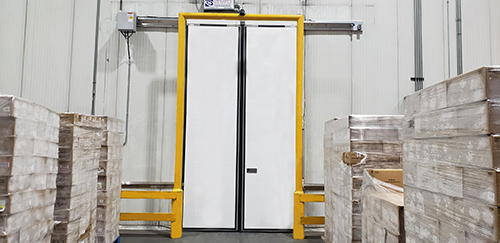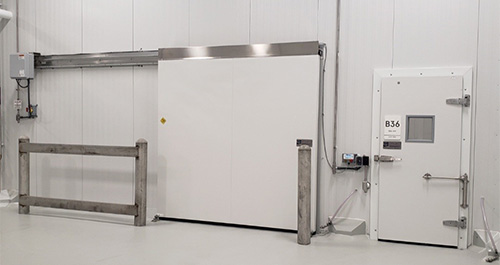 Manufacturers utilizing cold rooms have the unique job of maintaining proper thermal insulation that protects the stored product without interfering with operating practices. Keeping the cold room at the appropriate temperature is essential when protecting the quality and effectiveness of the products being stored.
Manufacturers utilizing cold rooms have the unique job of maintaining proper thermal insulation that protects the stored product without interfering with operating practices. Keeping the cold room at the appropriate temperature is essential when protecting the quality and effectiveness of the products being stored.
Food processing and pharmaceutical drugs often rely on low-temperature conditions to maintain high quality. Many high-end pharmaceuticals require an intensive operation structure and must be stored in refrigerated chambers to work correctly. When the storage facility cannot maintain proper temperatures, it affects the integrity and effectiveness of potentially life-saving drugs.
Frozen food distributors also rely on effective cold storage to protect their products. Storing frozen foods in cold storage facilities prevents them from going bad or impacting the customer. Food is a sensitive product that requires specific preparation, cold room freezing procedures, and a sealed doorway.
The main purpose of a cold room is to protect food, drugs, and other temperature-sensitive products. Some items require a freezer, while others need a cold room with a positive temperature. The technical characteristics of the cold room will determine the required temperature and necessary doors.
Properly utilizing a cold room for storage is an intensive operation. Factors like insulation thickness, thermal bridges, and cold room doors can all affect the thermal insulation of a cold room. Follow these five best practices for keeping your cold storage warehouse insulated at a low temperature.
1. Control the Heat Exchange
The primary challenge for manufacturers using cold storage facilities is maintaining an adequate temperature for their products. Some items like food require freezers, while others need cold rooms that are above freezing temperatures.
The best way to address these concerns is to use the correct insulation thickness and choose cold room doors that keep the heat out as much as possible. Ensuring that your cold room is using adequate thermal breaks keeps the coolers cold and the freezers freezing.
You insulate your home to keep it warm during the winter and cool during the summer. Since freezing chambers require lower temperatures, they need extra insulation and cold-proof doors to maintain a steady temperature. Operating a cold room requires having the technical characteristics to keep the stored products insulated while using doors that can withstand the cold.
Using specialized cold room doors helps to withstand temperature fluctuations. Constantly opening and closing a cold storage door allows heat to enter the cold room. Some cold rooms have customers or employees frequently coming in and out, making maintaining the necessary cold temperature challenging.
The best way to control the heat exchange is to use the right type of panel to keep the room insulated and find the best doorway option to prevent temperature fluctuations. Cold room doors are specially designed for opening and closing a doorway without letting too much cold from the freezer escape.
2. Use Cold-Proof Equipment
The cold is essential for properly storing your products, but it can also affect the efficiency of your equipment. Tablets and large machinery that are not designed to work in low temperatures will malfunction more frequently, making it harder to do your job.
For example, touch screen tablets are a convenient tool that helps with inventory and other manufacturing processes. Most touch screens rely on the heat from your finger for processing, making it difficult to use when you are wearing gloves. Using a touch screen that relies on pressure rather than heat will ensure that you can still use it in negative temperatures.
Rooms with fluctuating temperatures have a constant exchange of heat and cold, causing condensation. Forklifts, scanners, and pretty much every other important piece of machinery can malfunction when presented with condensation. Sealing these tools helps them withstand condensation and preserve battery life.
Cold room doors are an essential piece of equipment for cold storage. The main purpose of cold storage doors is to prevent heat from entering the doorway and control the temperature in the freezer.
3. Use an Automation System in Your Cold Room
Using cold rooms for storage is a more expensive endeavor than utilizing a standard storage facility. Keeping the room at a consistently low temperature takes time and energy.
The construction of a cold room focuses on the freezer structure and the cold storage door frame. Automation systems create a more efficient and convenient freezer operating system.
Using an automation system whenever possible in refrigerated chambers saves you time and money. Stacker cranes are a popular automatic system used for storing and retrieving items within a cold storage facility. They are an excellent asset to storage rooms with tall vertical racks.
Robotic pallet shuttles are another effective automation system. They operate similar to stacker cranes, but they can handle a greater density of products.
Using an automation system in your cold storage room reduces human error and improves overall efficiency, as even the most well-equipped employee is prone to mistakes.
A common mistake made by employees is accidentally leaving cold storage doors open. This action is an easy way to let the cold out and slowly reach a higher positive temperature, affecting the quality of the stored products.
Automation tools reduce the need for human labor and provide more consistent reliability.
4. Keep Your Cold Rooms Records Updated
Maintaining accurate records is a critical task for any job. This process is especially true for those in charge of cold room storage.
Keeping an accurate record of daily room temperatures ensures that you are properly storing your products. These records also give you a document to refer to if you ever encounter operating issues.
When it comes to maintaining cold rooms records, technology is your best friend. Specialized scanners provide an accurate and consistent temperature reading of the room while alerting you when the temperature drops or rises.
Trigger alarms are another helpful tool. You can keep track of who enters the cold room and when. Alarms will alert you when an unauthorized entry is happening.
Managing cold rooms in a storage facility can be complicated but keeping the correct records can simplify the job and keep your work organized.
5. Choose the Right Cold Room Doors
Choosing doors that fit the unique structure of your cold room is critical when maintaining a proper temperature. The right type of door will help control temperature and processing operations.
When it comes to choosing cold room doors, you have a lot of options.
Swinging or In-fit Cold Room Doors
A hinged door for your cold room works similar to the doors in your home or office building. Hinged doors, or swinging doors, are a popular option for small doorways. Swinging doors operate by opening up into one side of the area.
The width of your door panel will determine what size hinged door your facility needs. A manufacturer may prefer swinging cold room doors to improve a person’s passage space through smaller refrigerated chambers. Swinging doors provide a secure doorway and they provide a safe exit or means of egress for these rooms.
Sliding Cold Room Door
Sliding doors are another popular door panel option for cold rooms. Unlike swing doors, sliding doors do not open into one side. Instead, they save space by sliding across the wall and opening up the doorway into the freezer.
Sliding doors require specialized seals to insulate a cold room properly. The type of seal needed will depend on the technical characteristics of the cold room. This also means that sliding doors are not as easy to install and will require professional installation.
While a swinging door is ideal for a small doorway, a sliding door works best for large doorways. They will typically have wider door jambs requiring thicker freezer doors. Using sliding cold room doors instead of swinging doors saves space and creates a more straightforward entryway.
High-Speed Doors
High-speed doors are ideal for intensive operations with heavy traffic and large doorways. The main purpose of a high-speed door is to open and close a person’s passage as efficiently as possible.
A high-speed door is a convenient option for warehouses or industrial freezers. They operate similar to a garage door as they quickly roll to open and close. High-speed freezer doors effectively protect the thermal insulation of a room by allowing as little heat in as possible while keeping the cold in.
Although some high-speed doors can be used for small doorways, most industrial facilities prefer to use them for large doorways where a sliding door cannot be used due to limited side-to-side clearance. Their ability to quickly close and open makes it an ideal option for industrial-sized refrigerated chambers wanting to keep the maximum amount of cold in the room.
Your Cold Room Doors Experts
Whether you are in the business of storing food, pharmaceuticals, or any other item that requires freezers, ASI Doors, Inc. can help you with choosing doors and their ideal installation. Choosing cold room doors that protect sensitive temperature conditions and thermal breaks is essential when constructing a cold room.
ASI Doors offers cold room doors that fit the unique needs of every industrial or manufacturing facility, including:
- Sliding door
- Swinging door
- Small doorways
- Large doorways
If you are struggling with your decision, ASI Doors can help. We specialize in these applications and other high-performance high-speed door solutions. Contact us today!
